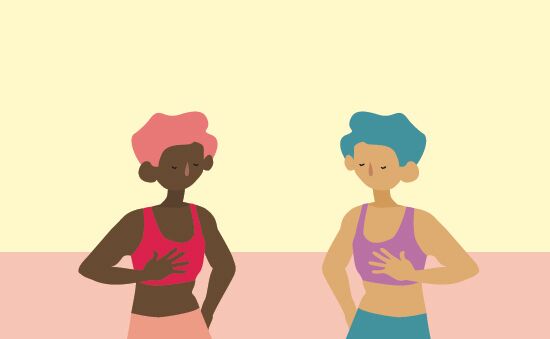Binding is a hugely important part of transgender healthcare. Compressing one’s chest to reduce or eliminate the visible appearance of breasts is vital to combat gender dysphoria and often to maintain a safe presentation in a transphobic world.
GC2B was one of the first binder brands that addressed this issue from a transmasculine perspective. As one of the biggest names in binding that was founded by a trans man, GC2B is the go-to for many folks who are just beginning to bind. I’m no exception. GC2B was the source of my first binder (in 2016) and also my second (in 2019,) and I still wear the latter on my masc-presenting days.
Related:
These 10 icons made healthcare more inclusive. Here’s how they did it
Queer leaders and allies have shaped not just the medical treatment of LGBTQ+ people but improved health care for all Americans.
But in the past couple of years, some GC2B customers have become unsatisfied. While those who bind are accustomed to soreness and are well aware of the health risks, there have been numerous complaints of sudden increases in pain and discomfort throughout social media and brand review platforms.
Dive deeper every day
Join our newsletter for thought-provoking commentary that goes beyond the surface of LGBTQ+ issues
These concerns range from higher levels of rib pain and skin irritation to incorrect sizing and poor customer service. While the brand was unavailable for comment on this particular article, it has addressed the concerns through social media and even dropped a new binder in response. But a glance at the comments of the Instagram announcement shows a customer base that’s still frustrated with the quality of its product.
To have clear and accessible discussions of healthy binding, we need to be able to talk about these issues practically and without contributing to the false fear that binding is inherently dangerous. GC2B is an important part of the nonbinary and transmasculine community, and while these concerns must be discussed, it’s important to acknowledge the difference the brand has made in the world of safe chest compression.
“Their model has addressed other innovations, [such as] making things affordable and available at a mass level,” says Frances Reed, founder of healthybinding.com and author of Healthy Chest Binding, which will be released in 2024. “I just want them to come back into the high quality game they started.”
When the founder of Urbody, Mere Abrams, first went looking for a binder, there weren’t any that were meant for trans people. Until GC2B, the only ones on the market were designed for cis men with gynecomastia, which aren’t very effective for disguising the AFAB (assigned female at birth) chest.
“GC2B binders provided helpful insight into how we got here today,” Abrams says. “Compression garments have come a long way and have a long way to go. Everyone takes what they’ve learned, and hopefully applies it to offerings that really cater to a lot of different body types.”
Experiences with chest binders vary widely by body type, which could be one reason why some GC2B customers are experiencing a shift in quality while others are just as satisfied with the brand as they always have been.
Those who bind regularly are used to the soreness that comes with several hours of compression, which is why sudden increases in their base level of pain can be so jarring. But does this mean the compression garment itself is the problem?
In a study conducted by Dr. Sarah Peitzmeier for The Binding Health Project, 20 people were asked to bind and fill out a daily survey for 90 days describing how long they bound, what type of binder they used, and their pain rating for the day.
“While the analysis is ongoing, for some people there is considerable variation in the pain they report daily,” says Peitzmeier. “Seeing spikes in pain is associated with binding more hours per day than you would usually bind, but we sometimes see ‘high pain days’ without an increase in hours per day spent binding.”
However, if your pain has increased without any other changes to your routine than a new binder, the garment could be the problem. “If you are having increases in rib pain or skin irritation, consider experimenting with a different binding method or changing your binding practice to see if you can resolve these issues,” says Peitzmeir.
Often, painful binding is a sign that the garment isn’t the right fit. Some GC2B customers purchased the same type and size of binder as they had previously, only to experience significantly more discomfort than they had in their previous order.
When someone purchases a binder online, they are putting their faith in the brand that its sizing information is correct. It’s the brand’s responsibility to make sure their size guides are accurate and up to date by thoroughly testing each garment.
“We can’t measure the garment,” says Reed. “We’re not trained in garment construction. That’s a skill. People who do it know what’s right and wrong about how something should fit. What makes me curious about this is whether there is inconsistency in their production.”
The brand hasn’t publicly acknowledged a change in fabric or manufacturers – in fact, there is no information about its supply chain publicly available on its website. Lack of transparency is an issue across the fashion industry, as less than half of major brands and retailers share their manufacturing facilities as of 2021. But it’s especially important for brands that directly impact their customers’ health to share this information.
“Everybody in the community has different needs and skin sensitivities,” says Reed.” The more you know about the chemicals on your clothing, especially a compression garment, the better off you are.”
In addition to transparency, binder brands must also be prepared to inform and educate their customer base on safe and healthy binding practices – especially with the lack of funding for binding research.
“Part of the problem in public health about binding is that the education isn’t out there,” says Reed. “If [someone] is getting a GC2B binder for the first time, they may think, oh, okay, I bought the wrong size and it’s painful and sore…but this must be what binding is.”
The root of this issue isn’t one brand or type of binder. It’s the lack of candid and accessible discussion around transgender health care.
“If binding were discussed positively and openly, trans and nonbinary people who bind would have access they need to bind in a healthy way for their body,” says Peitzmeier.
While the binding world has made great strides since the dangerous days of ace bandages, we still have a while to go before all of our siblings have access to the safe chest compression information and garments they need.
Ultimately, our community requires greater resources to affirm ourselves through a health-informed lens that acknowledges every body is different. We need places we can ask the hard questions, and get honest answers. We have to have open conversations and accept that there is no one binding brand or method that will work for everyone.
“Sometimes we see people get locked into the idea of ‘there is only one way to bind or ‘pain is just what I have to accept to bind,’ and we know that isn’t true!” says Peitzmeier. “While not everyone feels they have the resources or energy to experiment with new ways of binding, different ways are out there. It is possible to find a way to bind that reduces the negative physical symptoms while affirming your gender and supporting your mental health and safety.”
It is each person’s responsibility to monitor their body and bind safely with whatever method works best for them. But we deserve to be informed about the garments we choose to use.
I can’t promise that any specific binder or brand will be the right choice. I hope that soon, we can try on binders in-store to see how they feel before we invest our time and money, or perhaps made-to-order options will become more accessible so everyone can get the custom compression they need.
One thing is certain: You are worth a binding experience that doesn’t hurt more than it should. If you decide that GC2B is still the right brand for you, that’s wonderful. Just do your due diligence, double-check your measurements, and listen to your body. If it feels wrong, it’s wrong.
















We must include binding safety in conversations about trans health care